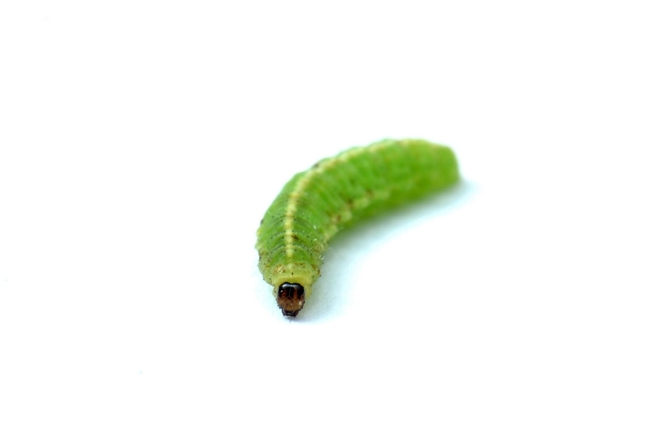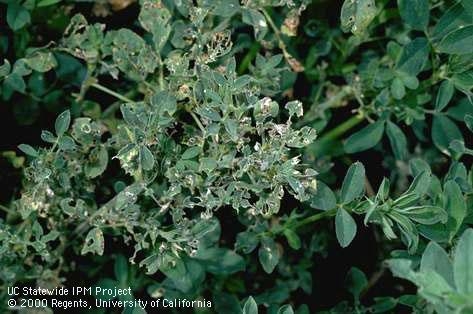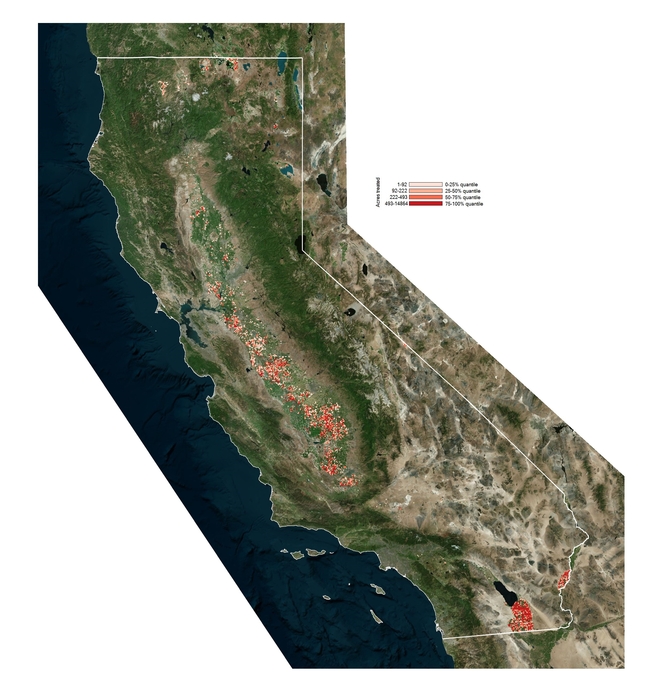The end is near for chlorpyrifos (Lorsban) applications in many California crops, now on a faster timetable than previously anticipated. This results from a recent agreement between CA Department of Pesticide Regulation (CA-DPR) and pesticide manufacturers to withdraw their products beginning in a few months (February 2020).
This is a major issue for alfalfa, since it is one of the most popular wide-spectrum insecticides for management of key alfalfa pests. These include the alfalfa weevil, Hypera postica, which chews on the foliage (Figure 1, Figure 2) and the aphid complex (several species) which suck juices from the plant – see UC IPM website http://ipm.ucanr.edu/PMG/selectnewpest.alfalfa-hay.html ).
Use of chlorpyrifos has declined in the past two years (due to increased restrictions) but still it was used on 153,000 acres of alfalfa hay in California 2017 (CA-DPR Pesticide Use Report and Figure 3).
Figure 1. Alfalfa weevil larva, a key pest in California's alfalfa fields in the spring months (January-May), reducing yields and quality from feeding on the foliage. Chlorpyrifos has been widely used to control this pest, but in 2020, growers will need to look for alternatives. (Photo: Ian Grettenburger)
What are the alternatives? Unfortunately, there are few alternative products available for alfalfa weevil control specifically. Examples include pyrethroids like Warrior, Steward, Malathion and Entrust (spinosad used for organic production). These have their own limitations, both in terms of efficacy and environmental impacts.
Unfortunately, alfalfa weevils frequently reach economic damaging thresholds in California and many growers find it necessary to spray. There are some other aphid-specific insecticides that would help with aphids but not with alfalfa weevil.
The problem of pesticide resistance. Weevil resistance to pyrethroids is beginning to be a problem throughout the Western states, including select areas in California such as the intermountain and low desert production areas. With the loss of chlorpyrifos, the over-use of a single class of insecticide could be a major challenge.
It has been a long-standing recommendation of the UC Integrated Pest Management Program to rotate insecticide classes to prevent insecticide resistance, in addition to ONLY spraying when thresholds reach an economic level. However, the reductions in active ingredient possibilities may exacerbate resistance.
What drives the withdrawal of chlorpyrifos? Chlorpyrifos was on the way out nationally in 2017 under Obama, but the EPA decision was reversed suddenly in March 2017 as administrations changed (see blog: Chlorpyrifos ban Averted at Last Minute). Chlorpyrifos was subsequently limited by California EPA (and now banned) since it has been designated as a toxic air contaminant and associated with negative health effects in sensitive groups. Chlorpyrifos has been around for many years and used to control pests on a variety of crops, including alfalfa (primarily weevils), as well as on almonds, citrus, cotton, grapes and walnuts. Chlorpyrifos is marketed as Lorsban, Vulcan, Stallion, Cobalt, and Lock-On among others.
The agreement between DPR and manufactures states that:
- All sales of chlorpyrifos products to growers in California will end on Feb. 6, 2020.
- Users can continue to use chlorpyrifos products until December 31, 2020.
- Until then, all uses must comply with existing restrictions, including a ban on aerial spraying, quarter-mile buffer zones and limiting use to crop-pest combinations that lack alternatives.
- Product take-back will occur through normal business practices/channels – with outreach to growers to explain the terms of continued use.
A few products that apply chlorpyrifos in granular form (e.g. for cutworm control), will possibly be allowed to remain on the market (but not registered for use in alfalfa).
The need for alternatives. UC Cooperative Extension advisors and specialists throughout the state are working on developing alternatives to chlorpyrifos in many crops. This work is being supported through the current California state budget, which has appropriated more than $5 million in grant funding for the purpose.
- DPR will award more than $2.1 million in grants to fund projects that identify, develop, and implement safer, practical, and sustainable pest management alternatives to chlorpyrifos.
- CDFA will award approximately $2 million in grants to expand outreach about innovative, biologically integrated farming systems that reduce chemical insecticide inputs. Crops that have used chlorpyrifos will be a priority.
- CFDA will also fund approximately $1.5 million in research to develop alternatives to chlorpyrifos that provide safer, more sustainable pest management solutions.
Non-pesticide options. There are important non-pesticide approaches for weevil and aphid management, including grazing to reduce winter stem egg-laying, early harvest, and introduction of biological controls which are detailed in our IPM guidelines, http://ipm.ucanr.edu/. Additionally, scouting for pest numbers and predation (infected larvae which reduce impacts of the pests) are important tools.
Critical need for alternatives. However, in spite of many of these efforts, many growers have found it necessary to spray (Figure 3), and now will have to look hard for viable alternatives. Following UC IPM guidelines for managing pests, including selecting locally adapted varieties with high levels of pest and disease resistance, are important steps to managing pests and reducing reliance on pesticide use in alfalfa fields.
Figure 3. Map of Chlorpyrifos applications, CA, 2013-2017. Chlorpryifos has been used throughout the major alfalfa growing areas of California (Intermountain, Central Valley, and Desert) for many years, mostly for alfalfa weevil and aphid control - a practice which will wind down in 2020. Data: CA Pesticide Use Report.
This article was originally posted in Alfalfa & Forage News.


